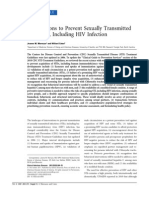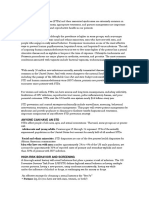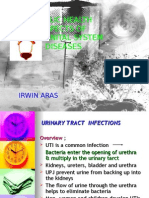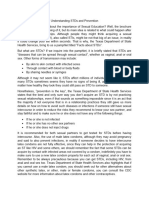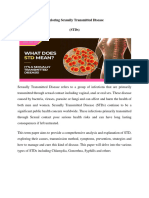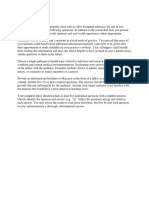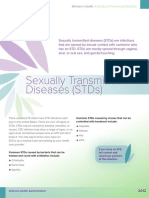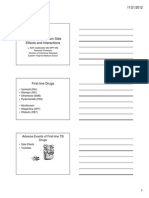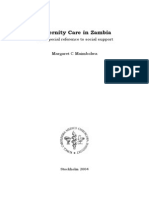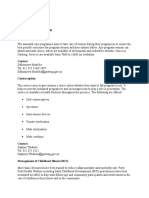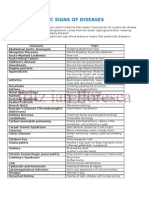Week 4 Assignment
Week 4 Assignment: Media Pitch
Amy D. Lynch
Purdue University
�Week 4 Assignment
2
Abstract
In this case, a media relations director for the Center for Disease Control, is working to
pitch a recently released study by the organization about the substantial rise in sexually
transmitted diseases (STD) in the United States. The study was released on October 19, 2016. As
part of the national newspaper pitch for the study, the media relations director with the CDC,
contacted Liz Szabo, medical reporter for USA Today, with whom they have a good working
relationship with to pitch stories and offer professional sources to quote for articles and research
information for USA Today. The phone conversation has taken place and this paper includes the
email that Szabo requested with further information to develop the story into a weekend package,
along with facts sheets and other important information.
�Week 4 Assignment
Email:
To: LSzabo@usatoday.com
From: amy.lynch@CDC.org
Subject: STDs at Unparalleled High: STD Surveillance Report reveals
Liz,
It was nice catching up with you today on the phone and thank you for your time. I can
easily have some information for you and quotes regarding flu season next week for your
enterprise piece. Also, as per our conversation this morning, enclosed/attached in this email is
information for the CDCs recent release on our 2015 study on STDs. I know you said it looked
like this would be a Sunday health feature package so I have also included a quick facts sheet
and infographics so you can easily pull information for infoboxes. Please let me know if you
need additional information or quotes and I would be happy to connect you with the right people.
Enclosed is the following:
Press Release
Info Graphics/Fact Sheet and Prevention
Thank you again and talk to you soon!
Amy Lynch
CDC Media Relations Director
Cell: (444) 789-1234
Office: (444) 987-4321
�Week 4 Assignment
Press Release:
Center for Disease Control
STDs Reach Unparalleled Highs
New efforts needed in reviving eroded system to help decrease the risk of infection
ATLANTA, GA. (Oct. 19, 2016)- Cases of chlamydia (39 percent) and gonorrhea (32 percent)
have reached an all-time high with the largest majority among 15 to 24 year-olds according to a
Sexually Transmitted Disease Surveillance Report released by the Center for Disease Control.
The 2015 study revealed more than 1.5 million chlamydia cases were reported (1,526,658),
approximately 400,000 cases of gonorrhea (395,216), and about 24,000 cases of primary and
secondary (P&S) syphilis (23,872). The largest increase in cases reported between 2014 to 2015,
occurred in P&S syphilis (19 percent), followed by gonorrhea (12.8 percent) and chlamydia (5.9
percent). A record high in the U.S. has been reported for chlamydia, gonorrhea and syphilis.
We have reached a decisive moment for the nation, said Dr. Jonathan Mermin, director of
CDCs National Center for HIV/AIDS, Viral Hepatitis, STD, and TB Prevention. STD rates are
rising, and many of the countrys systems for preventing STDs have eroded. We must mobilize,
rebuild and expand services or the human and economic burden will continue to grow. It is
especially startling to see the massive rise in our nations young population. Seeing the rise in 15
to 24 year-olds means there has been a breakdown in educating our high school and college-aged
students.
State and federal budgets for STD preventative and testing programs continue to be cut since the
2008 recession. These dwindling funds accounted for 69 percent of states budgetary cut in STD
program funding in 2009 alone. Most have resulted in reduction in staff funding made to
�Week 4 Assignment
laboratory, clinical care and screening services. Since 2005, federal governmental STD program
funding has decreased more than $6 million.
Chlamydia, gonorrhea and syphilis are curable with antibiotics. Widespread access to screening
and treatment would reduce their spread, Dr. Gail Bolan, Director of CDCs Division of STD
Prevention, said. Most STD cases continue to go undiagnosed and untreated, putting individuals
at risk for severe and often irreversible health consequences, including infertility, chronic pain
and increased risk for HIV. STDs also impose a substantial economic burden: CDC estimates
STD cases cost the U.S. healthcare system nearly $16 billion each year.
Although infection rates continue to increase among both men and women, men account for 90
percent of both primary and secondary syphilis cases. Gay and bisexual men are reported to be at
the highest risk for syphilis infection with a rate increase of 19 percent in 2015.
STD prevention resources across the nation are stretched thin, and were beginning to see
people slip through the public health safety net, said Dr. Mermin. Turning the STD epidemics
around requires bolstering prevention efforts and addressing new challenges but the payoff is
substantial in terms of improving health, reducing disparities and saving billions of dollars.
For more information, contact Amy Lynch, CDC media relations director, at (444) 987-4321, or
at amy.lynch@CDC.org.
�Week 4 Assignment
Info graphic:
References
CDC. (2016). 2015 STD surveillance report press release. Center for Disease Control. Retrieved
on November 10, 2016 from http://www.cdc.gov/nchhstp/newsroom/2016/stdsurveillance-report-2015-press-release.html.
CDC. (2016). 2015 STD surveillance report facts sheet. Center for Disease Control. Retrieved on
November 10, 2016 from http://www.cdc.gov/nchhstp/newsroom/docs/factsheets/stdtrends-508.pdf.
�Week 4 Assignment
NCSD. (2015). Funding landscape. National Coalition of STD Directors. Retrieved on
November 10, 2016 from http://www.ncsddc.org/funding-landscape.



